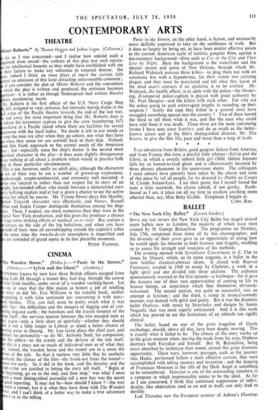CINEMA he Wooden .Horse." (Rialto.)—"" Panic in the Streets." (Odeon.)—"
Sylvia and the Ghost." (Academy.) 'ERYBODY knows by now how three British officers escaped from lag Luft III through a tunnel they had dug, through the course four tired months, under cover of a wooden vaulting-horse. Let say at once that the film makes as honest a job of retelling e story as did Mr. Eric Williams in his notable book, neither eapening it with false sentiment nor coarsening it with story- ok heroics. This, you feel, must be pretty much what it was Ily like: the difficulties and the dangers of digging and of con- hng dug-out earth ; the boredom and the frayed tempers of the nip itself ; the nervous tension between the two escaped men as ey argue—only a little short of spitefully—whether they should ck it out a little longer in Lubeck or stand a better chance of wing away in Danzig. Mr. Leo Genn plays the chief part, and bdues his personality—as do Mr. Anthony Steel, his companion, d the others—to the events and the devices of the tale itself. r this is a story not so much of individual men as of what they d ; indeed, the wooden horse and the tunnel are in a sense the roes of the tale. So that it matters very little that by aesthetic ndards the climax of the film—the break-out from the tunnel- mes too early. So it did in the book, and the director and the ript-writer are justified in letting the story tell itself. " Begin at e beginning, go on to the end, and then stop," was what I once and a most distinguished journalist tell a new boy was the secret good reporting. It may not be—how should I know ?—the way write a sonnet, but it is what they have done with The Wooden orse, and I can't think of a better way to make a true adventure em true in the telling. Panic in the Streets, on the other hand, is fiction, and necessarily more skilfully contrived to take on the semblance of truth. But it does so largely by being set, as have been similar effective pieces in the current American cycle of realistic gangster films, against a documentary background—films such as Cry of the City and They Live by Night. Here the background is the waterfront and the sleazier streets and joints of New Orleans, through which Mr. Richard Widmark pursues three killers—to plug them not with an automatic but with a hypodermic, for their victim was carrying plague, and they must be inoculated and tell what they know of the dead man's contacts if an epidemic is to be averted. Mr. Widmark, the health officer, is at odds with the police—the bluster- ing, ill-tempered police-captain is played with great authority by Mr. Paul Douglas—and the killers with each other. For why are the police going to such extravagant lengths in rounding up their suspects ? Surely the man they killed in a quarrel must have smuggled something special into the country ? Two of them hound the third to tell them what it was, and flee the man who could have told them it was death. These three are the most convincing brutes I have seen since Scarface, and do as much as the better- known actors and as the film's distinguished director, Mr. Elia Kazan, to give the film life, pace and more than a tang of truth. * * * True adventure from Britain, good gangster fiction from America, and from France, this time, a playful little whimsy—Sylvia and the Ghost, in which a sweetly solemn little girl (Mlle. Odette Joyeux) falls for an honest-to-God ghost, and is affectionately haunted by three phoney phantoms in the spare-room sheets. The colleagues I most admire have patently been taken by the charm and taste of this piece by (of all people, for he directed Le Diable au Corps) M. Claude Autant-Lara. I see their point, but I myself found the taste a little mawkish, the charm coltish, if not gawky. Earth- bound as I am, it takes me all my time to swallow anything more ethereal than, say, Miss Betty Grable. Ectoplasm I boggle at.
CYRIL RAY.


































 Previous page
Previous page